Why Sun Valley closed its doors
I never like to hear about a long-standing, successful business suddenly shutting down. But when it happens, I do like to know why, and share the details, in hopes that others can learn from the situation.
California-based cut flower grower Sun Valley Floral Farms recently shook up the cut flower world with the news of its pending closing. We knew something drastic was happening back in May, when news came out that Sun Valley had issued layoff notices to their Arcata and Oxnard workforces under the federal WARN (worker adjustment and retraining notification) Act.
Now CEO and President Lane DeVries, who has been with the company since 1984, has written a letter to customers and the industry in general citing the causes of the tough decision he and the company leaders had to make.
After its start in 1948, Sun Valley grew rapidly, expanding to three locations—Arcata, Willow Creek and Oxnard, California—and more than 400 employees to keep up with the demand for their flowers, especially bulb crops like year-round tulips (made possible thanks to a partnership with a New Zealand grower).

Sun Valley (continued)
However, setbacks began piling up with the Great Recession. Cited Lane:
- “In 2008, we lost 75% of our workforce in Arcata due to an immigration action by the government. The ensuing domino effect on operations lasted for nearly 18 months and left the company with a huge financial hole, and lasting scars.
- “In 2019, FTD/Proflowers, one of Sun Valley’s largest customers at the time, filed for bankruptcy right after Mother’s Day and several million dollars never were paid.”
- “The pandemic in the Spring of 2020 left us with millions of flowers blooming in the greenhouses.”
- “At the same time, business conditions in California have made operating a greenhouse flower company very challenging. The rising cost due to a series of rapid minimum wages increases, and the phased-out elimination of the agricultural overtime exemption has seriously raised the company’s unit cost in recent years.”
- “Insurance expenses have quadrupled in the last five years. Natural gas costs have gone up dramatically and electricity expenses have nearly tripled in the last 10 years.”
Lane concluded, “These cumulative factors had a dramatic impact on our competitive position in the marketplace. In many cases our customers were unwilling to accept price increases needed to offset the cost increases.
“These conditions have put the company deeper into debt, and with the current interest rates, it has deteriorated the financial state of the company.
“As owners, we reached the point of having difficulty seeing a viable way out on our own accord.
“In the last 12 months the company has searched for a suitable investor or a buyer for the entire business. While there were some leads, no buyer for the entire company materialized.
“This left us at the point of closing the doors …”
Lastly, in a small bright spot, they managed to transfer the leases on their Willow Creek farm to Continental Floral Greens where they produce ilex, rosehips, cotinus, snowberries and viburnum. And Continental will be growing some core Sun Valley flowering crops, such as Butterfly ranunculus and possibly iris.
As for Lane, he says he will take on an advisory/consulting role with Continental.
Sun Valley’s story is not dissimilar to that of another West Coast nursery, Skagit Garden, which closed earlier this spring. They cited “current economic issues including market pressures, production cost, energy cost, freight cost and the business climate in the State of Washington” as all contributing to the decision.
Thoughts on the topic? Let me know HERE.

How Costa employees beat the heat
Whew, it’s been hot this summer. And it has been extra-hot in Florida. Miami even broke a heat record back in May, when it hit 96F (86F is the average high). And it hasn’t really cooled down since. That’s why Costa Farms, which has hundreds of employees working outdoors on more than a thousand acres of nursery property in Homestead, south of Miami, has decided to get really serious about heat safety for its workers, enhancing working conditions and implementing rigorous heat protection standards. The company even goes beyond OSHA guidelines, actively advocating for higher worker safety standards.
What have they done to help workers stay healthy when dealing with summer heat in the workplace? Six things, reports Stacey Pierson of Garden Media Group, who spoke with Costa’s Justin Hancock on the topic.
Regular breaks in shaded, cool areas. “While we have a mandatory 30-minute break every morning and every afternoon, Costa Farms team members are encouraged to take breaks as often—and as long—as they feel they need to stay healthy,” says Justin. “Some team leaders will add mandatory breaks for their teams, depending on conditions.
“Most employees work under shade, since the majority of our plants are grown under shadehouses. But for areas where we grow crops in full sun, team members can find shade from nearby trees or jump on a golf cart or Gator [utility vehicle] and get to a nearby shaded or air-conditioned break room.”
Adjustments in work hours during heat waves. Says Justin, “Depending on the manager/task, managers may choose to rearrange order of tasks, for example, pruning eugenia topiary in full sun first thing in the morning and then moving pruning tasks to shade houses as the heat builds throughout the day.”
Ample electrolyte water hydration stations are placed strategically across the farm. “Gatorade and other sports drinks are offered in addition to water in work areas,” says Justin. “In areas like the packing house, there are stations set up. In the field, water and electrolyte drinks are provided in coolers. We have frozen electrolyte popsicles in some work areas where we have freezer capacity or can use a mobile ice cream cart.”

In addition to those specific cooling-off opportunities, Costa provides continuous training programs for employees on heat safety and prevention so they know the signs of heat stress and how to protect themselves. And they’ve taken the extra step of having a full-time registered nurse on site to educate and aid employees regarding heat safety.
Popsicles? Sign me up!

Zurko visits Smith Gardens to see what’s growing
GrowerTalks editor Jen Zurko takes to the road once again, this time to the Pacific Northwest where she had the opportunity to see what Smith Gardens is doing with their newest location, the former Skagit Gardens.
Right after Cultivate, I took a much-needed break to visit my sister, who lives about 25 minutes east of Seattle. Because I can’t fully take a vacation, I also timed it so that I could visit Smith Gardens, who was holding their 10th annual field trials open house on July 24.
But, first, I met Eric Smith at their new location in Mount Vernon. Back in April, I reported that Smith Gardens had acquired the facility from Skagit Horticulture, which included all the inventory that was already in production. Since I was going to be in the area, I wanted to check it out and ask Eric how it was going.
Eric admitted again that the transaction happened very fast. It was a surprise to them, but when the opportunity presented itself, he and his brother Mark felt it was the right decision to help expand their business.
In early April when they stepped in, most of the inventory for IGCs was already sold. They operated in about 1/3 of the space and observed the River Bend team’s processes (as they now call the location because it’s on River Bend Road) and how they managed production, inventory and distribution compared with Smith’s other locations.
Eric said that the River Bend location integrated very well and now plans are in the works for the future of the location. There are 16 acres of heated hoophouses and 8 acres of “warm” greenhouses at River Bend, so the plan is to continue to rotate a mix of annuals and perennials there. With all of this extra ideal space, Eric said it will allow them to really expand and optimize their perennial offerings for better winter protection and proximity to the market. It’ll be a bit of a learning curve for them, but that’s one of the reasons why they were eager to keep on as many team members as possible since they know the product and the production regimes.
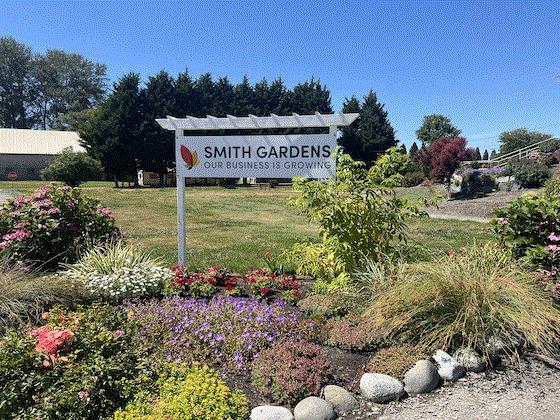
Smith Gardens already had a sign at the newly acquired River Bend facility in Mount Vernon.
“One of the fun things was to step into someone else’s plan and learn about new perennial varieties and what works,” said Eric. “The learning process of watching crops this spring will help us plan crops for next year at the River Bend location.”
Now that the spring season is in the rearview mirror, Eric said they’re looking at short- and long-term improvements and additions for the River Bend location. Along with scrutinizing the basic systems of heating, cooling and fertigation, and staff facilities, they’re thinking about better, more automated, systems to move plants around the site (more on that below).
River Bend is a finishing and propagation location and Eric said he’s happy for the extra space. He said the impact the River Bend location will have is that they get to plan with less capacity concerns than they’ve had with the other sites, which will, in turn, allow them to gain in both efficiency and quality.
“I’m pleased to be able to incorporate and utilize what they had here and to move forward with it,” Eric said.
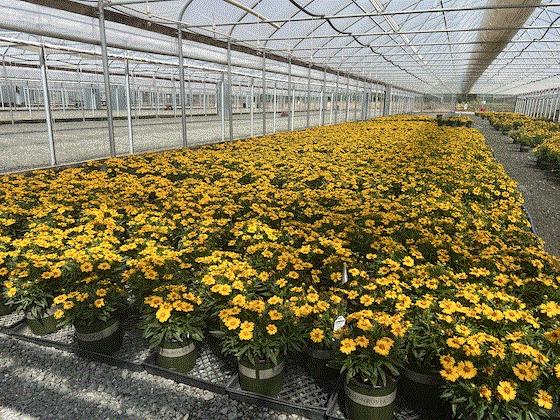
Smith will be using the new location to expand on their perennial offerings, like rudbeckia, hardy hibiscus and coreopsis.
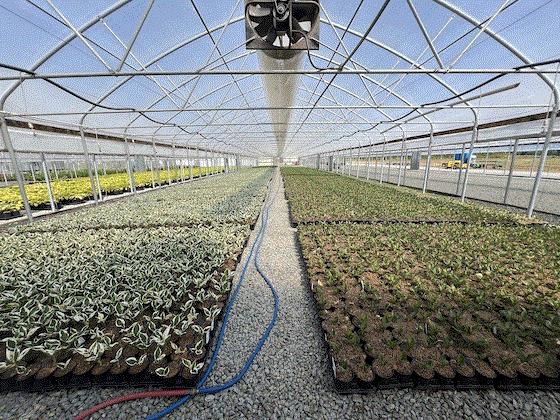
Recently planted hostas will be ready for next year’s perennial sales.

At Smith’s Field Trials
The next day, I attended Smith Garden’s Field Trials at their main location in Marysville. Denise Mullins, Director of Product Innovation for Smith, said that over the past 10 years the trials gardens have really grown. They started with just four raised beds; now they’re up to 20 on 1 1/2 acres. There are more than 1,500 varieties in the trials from 18 different breeders.
“We’re one of the few on the West Coast who holds an open house for the industry,” Denise explained. “It’s a way for them to come here and market their varieties to growers in the Pacific Northwest.”
The day I was there the weather was picture-perfect, but for a couple of weeks before that it was unusually hot, with temps in the 90s, which is rare for that part of the country. But the Smith team worked hard to make sure that the plants didn’t look like they’d been stressed at all. And for Denise and her team, all of the hard work is worth it.
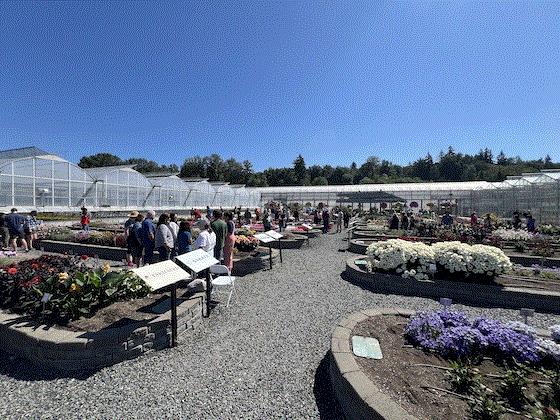
The Smith Gardens 10th annual Field Trials.
“It’s not a revenue generator for us; it just helps us focus on the varieties in a different way,” she said. “It allows us to get ahead with the next two retail years—it’s a great place to sell to our buyers. And our customers can see how the plants look in the landscape. It’s just a really good tool to have.”
As with many other regional events this year, Smith had record attendance at their trials this year, with close to 300 registrations. Denise feels like all their hard work and extra promotion through the breeders and trade media is paying off.
“We started so small and we’ve been working and building up over the years that we’ve grown organically,” she said.
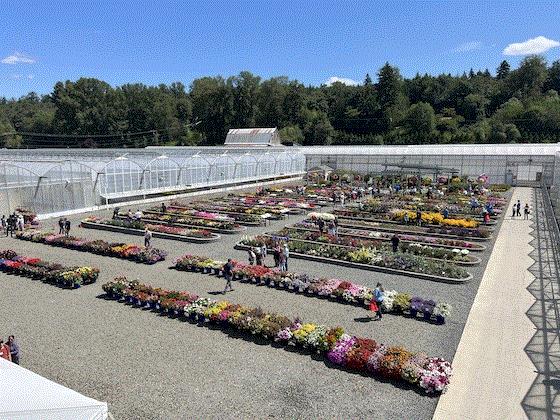
 I was able to strap on a harness and get up in a SkyTrak to take a few bird’s-eye photos with three industry pals. From left: Sarita Cantu, Smith Gardens; April Herring-Murray, PP&L; and Denise Mullins, Smith Gardens. We needed each other's moral support since all of us hate heights.
I was able to strap on a harness and get up in a SkyTrak to take a few bird’s-eye photos with three industry pals. From left: Sarita Cantu, Smith Gardens; April Herring-Murray, PP&L; and Denise Mullins, Smith Gardens. We needed each other's moral support since all of us hate heights.

Fork it over
While I was at Smith, I tagged along with a small group to see the new plant fork machines they started using two years ago. When I was with Eric at the River Bend location, this is one aspect of automation that he said he’d like to implement there.
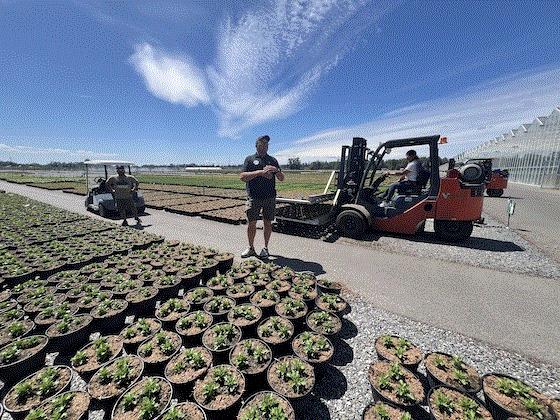
Smith Gardens’ Site Manager John Mencheski talking about their new plant fork machines.
Smith has two different machines: A double plant-moving fork that has two levels of forks to cart plants around; and a single plant-spacing fork to help space plants out in the field and in the greenhouse.
Smith’s Site Manager John Mencheski said there are 50 acres of outdoor production at the Marysville location, along with 12 1/2 under cover. The fork machines work great outside, but they wanted to use them inside as well, so John said they added 1 acre to their production area to make room for the plant-moving fork to navigate.
John estimates they saved over 15,000 hours of time during this past spring. What used to take 12 to 14 people to move the plants on conveyors and space them out, now takes three to six people, including the driver.
“It does take some practice, and you may still need one person to adjust the spacing, but it still saves a ton of time and labor,” said John.
Over two years, John said they’ve saved more than 54,000 labor hours using just two fork machines.

This is the plant-moving fork that has two levels to move twice as many pots.
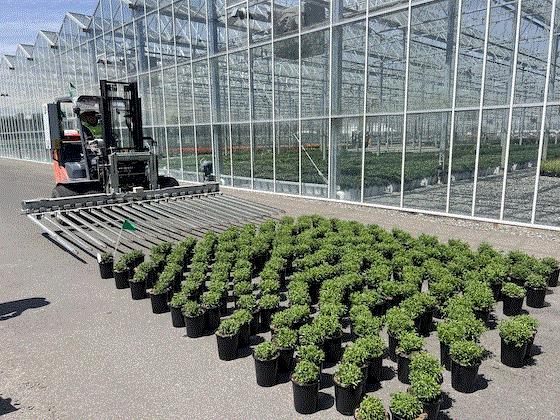
The single plant-spacing fork is extremely helpful during outdoor mum season when you’re moving 50 acres of plants around like the folks at Smith are.

Getting consumers in the (furniture) store
I think I told you I subscribe to Furniture Today, a twice-monthly tabloid serving the furniture industry. Furniture sales are tough, and we can learn a bit from that competitive market.
In a recent issue, the editors asked, “What needs to happen to get consumers in the store?” A batch of store folks answered, and I’ve cherry picked the most thoughtful remarks that make the most sense for our industry and left out things like “lower interest rates” and “lower inflation,” which they know is beyond their control anyway. I also ignored sales and financing. Let me know HERE if these make sense for our industry:
“I think consumers want something new, exciting, presentable, fresh and affordable. The store environment needs to be updated, modern, well-lit, visually stunning and inviting. The sales staff needs to be knowledgeable, presentable, not pushy and seen as trusted advisors and consultants. The product needs to be compelling in looks, features, delivery speed and affordability.”—Charlie Malouf, President/CEO, Broad River Retail, Fort Mills, South Carolina
“Authenticity and trustworthiness are more important in the consumer space than ever before. The days of haggling for deals are done; younger consumers want genuine companies that reflect their own personal values. Millennials and Gen Zs, who hold the majority of the buying power, don’t want to be ‘sold’ to. They want to feel empowered to make the right decisions and to purchase from a company they are proud of.”—Sara Horacek, Creative Director, Furniture Mart USA, Sioux Falls, South Dakota
“One of the things we’re doing to get people in store is with better customer service. We’ve always been good at customer service, but we’re delivering furniture in three or four hours, and I call the customers every day to make sure their experience has been good. We’re making an effort to make sure every customer is being taken care of. Every customer is vitally important to the enterprise.”—Jim McIngvale, owner, Gallery Furniture, Houston, Texas
“Modern consumers seek brands that align with their values. It’s essential to offer what they desire and inspire them, transcending mere affordability. Trustworthiness and community engagement are paramount; customers need assurance that the retailer shares their principles. In our approach, we prioritize service alongside style and quality, a commitment that deeply resonates with our clientele.”—Michael Galloway, VP of Marketing, Star Furniture, Houston, Texas
“I believe a couple things need to happen to get customers into the store. First, you have to make it personal for them. Since they can buy so much from their couch, we need to make the in-store experience worth the trip with something that makes them feel special: exclusive promotions, personalized service, and before- or after-hours appointments or events. Then you want to stand out as the company that really cares about the community. Show that you are truly local. Engage the community through sponsorships or fundraising or something the big guys can’t do. Then have the cool stuff that people want to buy and help them shop it in a way that will truly solve a problem for them …”—Jessica Talsma-Smith, Store Manager and Buyer, Talsma Furniture, Hudsonville, Michigan

SAF winners from their convention
Society of American Florists’ (SAF) 139th annual convention in Miami August 6-9 brought together more than 500 floral professionals to learn and to celebrate. At their annual Stars of the Industry Awards Experience, SAF honored some folks “who have made an indelible mark on the industry.” Perhaps you recognize some names:
SAF President’s Award Winner: Ian Prosser, AAF, AIFD, PFCI
Alex Laurie Award Winner: Dr. Paul R. Fisher, Ph.D
Tommy Bright Award Winner: Leanne Kesler, AAF, AIFD, FDI, PFCI
Paul Ecke, Jr. Award Winner: Tim Farrell, AAF, AIFD, CFD, PFCI
Next Gen Rising Star Award Winner: Jenny Thomasson, AAF, AIFD, EMC, PFCI
Floriculture Hall of Fame Inductee (posthumously): Paul Leonard Daum
Sylvia Cup Competition Winner: Jackie Lacey, AAF, AIFD, CFD, PFCI
Marketer of the Year Award Winner: Tiger Lily Florist
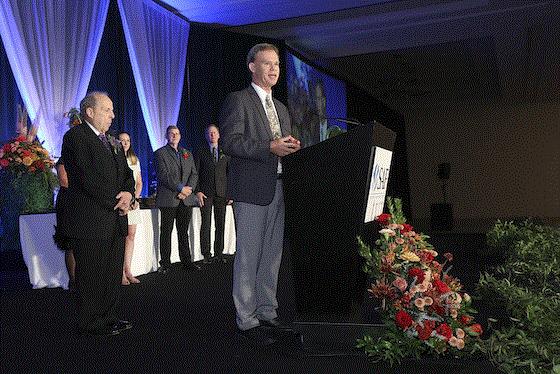
Personally, I know Dr. Fisher, a Kiwi who has found a home at my alma mater, the University of Florida. The Alex Laurie Award celebrates individuals who have made broad-scope, long-lasting contributions to floriculture research and education, and he has certainly done that over his 30-year career. He has help establish various projects for floriculture research, including the Floriculture Research Alliance and CleanWater3 (reduce, remediate, recycle). And he’s authored zillions of papers and articles that help growers around the world do a better job.
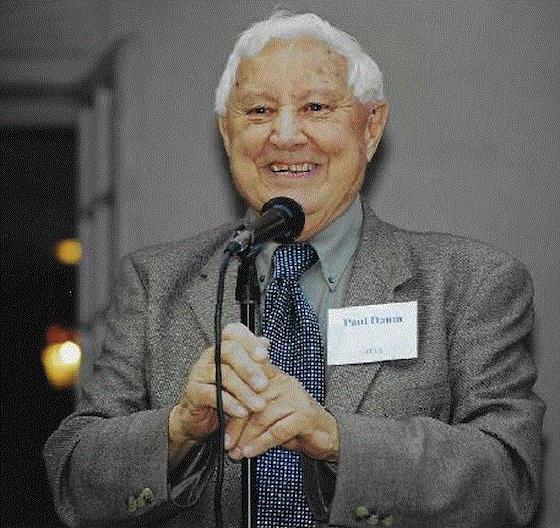
I also knew the late Paul Daum, long-time Gloeckner sales rep who passed away in 2020 at the age of 95. Talk about a career! He is known as “the father of the South American Flower Industry” for his work with the U.S. Agency for International Development, which identified that carnations would flourish in the Colombian Andes.
But I knew him as the Gloeckner rep who stopped by my fledging Florida nursery in 1983, right after we’d sold out of our first poinsettia crop and were wondering how to get flowering plants for Valentine’s Day. Paul hooked us up, and quickly, and he became a trusted source of new crop information. If you knew him, you knew he always had a stack of file folders under his arm, filled with brochures and articles torn from trade magazines. I like to think some of what I wrote wound up in those folders.
Congrats to all the honorees!

Bower & Branch acquires online landscape design firm Tilly
I didn’t know there was an online landscape design firm, but apparently there is—called Tilly—and Bower & Branch, the online marketplace for independent growers to sell trees and plants direct to consumers, has just acquired them with the goal of vertical integration—from shopping for trees and shrubs online, to landscape design for those plants, and even professional installation.
“The future of this industry is online, and our investment in Tilly supports that in a big way,” stated Don Eaton, Chief Executive Officer of Bower & Branch in the press release. “In addition to their professional expertise and leadership, Tilly brings value through its proprietary technology and access to new markets, serving our business model and grower network well.”
Who is Tilly? Says the press release, “Established in 2019, Tilly is a female-founded, online landscape design company servicing homeowners and landscape professionals throughout the U.S. Developed by a nationally recognized landscape architect, Tilly’s innovative remote-first approach matches customers with a vetted and trained landscape designer. The result is a truly custom, professional plan designed to meet their specific needs and environmental conditions.”
Tilly is supported by Colorado-based private equity firm Denver Angels, which has also agreed to lead a Series A funding round for Bower & Branch “to fuel its growth and expansion.”
“Tilly has dedicated the last five years to mastering and scaling online landscape design. Following our customers’ lead, we are excited to solve their next major pain point—plant fulfillment,” says Alexis Sutton, Chief Executive Officer of Tilly. “An overwhelming majority of the homeowners we serve also want us to fulfill their plant orders, making this a significant growth opportunity. Tapping into Bower & Branch’s extensive grower network and curbside delivery service will allow us to seamlessly bring their design vision to life.”
Tilly’s CEO Alexis Sutton, CMO Sarah Finazzo and Design Director Cate Singleton will transition to Bower & Branch, with Sutton becoming President of the combined entity and focusing on the expansion of the PRO network across the country, and Finazzo becoming Chief Communications Officer.
Bower & Branch was founded by Don Eaton while managing his family’s 175-acre farm in Pennsylvania. He spent years studying the industry and recognized the need to digitize grower inventories for sale online. Bower & Branch specializes in trees that can’t be shipped in a box but are instead delivered via an extensive trucking network. Their product includes bulk plant orders and trees up to 30 feet tall, which are delivered from their grower network to the homeowner’s curb.

New Mainspring Xtra has two modes of action
Syngenta’s Mainspring Xtra insecticide is now available for use in greenhouses, nurseries and ornamental landscapes. Mainspring Xtra has two modes of action, featuring the active ingredients cyantraniliprole (IRAC Group 28), which delivers broad-spectrum residual control of chewing and sucking insects like thrips, aphids and caterpillars; and thiamethoxam (IRAC Group 4A), which provides fast knockdown of hard-to-control insects like whiteflies and leafminers. Mainspring GNL, which you may be familiar with, only contains cyantraniliprole.

Mainspring Xtra can be applied by spray, drench, cold fog and chemigation using low-use rates. In addition to the residual performance of cyantraniliprole and the fast-acting, systemic nature of thiamethoxam, applications of Mainspring Xtra can also increase plant vigor because of the patented Thiamethoxam Vigor Effect. Research has shown that thiamethoxam leads to enhanced root mass when compared to untreated plants and improves overall plant quality by strengthening stems and producing greener plants.
“Mainspring Xtra is ideal for growers who want to not only prevent insect populations before they build but also quickly knock down existing insects,” said Carson Cashwell, market manager for ornamentals for Syngenta Professional Solutions.
In addition to traditional ornamental, tree and shrub crops, Mainspring Xtra is also labeled for use on non-bearing fruit and nut trees as well as vegetable transplants grown for resale to consumers.
“One of the main differences between Mainspring GNL and Mainspring Xtra is the addition of edibles to the Mainspring Xtra label,” explained Laurie Riggs, insecticide brand manager for Syngenta Professional Solutions. “This gives ornamental growers one product they can use for insect control across all the crops in their operation.”
For more information and to view trial data, click HERE.

Breeder Showcase at the Cincinnati Zoo & Botanical Gardens
If you’re within driving distance of the above garden spot on August 28, stop in for a look-see at the Breeder Showcase & Trials put on by CZBG and EHR (Eason Horticultural Resources). It’s the second year of the event.

With the support of EHR and more than 40 other sponsors, the Breeder Showcase highlights summer performance of plants inside and around the zoo. An additional stop at the Rockdale Urban Learning Center gardens gives visitors a peek at one of their growing sites and the zoo’s efforts to connect plants with the local community.
Last year, the event attracted more than 300 plant enthusiasts and captivated more than one million zoo-goers throughout the season, establishing CZBG as a pivotal hub for flower breeders and end consumers.

New this year, attendees end the day at a tradeshow with zoo staff, plant breeders and vendors, as well as a sneak peek into the CZBG’s new exhibit: Elephant Trek.
If you’d like more information about the Breeder Showcase Day, CLICK HERE.



Feel free to email me at beytes@growertalks.com if you have ideas, comments or questions.
See you next time!

Chris Beytes
Editor-in-Chief
GrowerTalks and Green Profit
This e-mail received by 28,912 loyal readers!
Thanks to my loyal sponsors, who help me reach the 28,856 readers of Acres Online in more than 60 countries. Want to be one of them (a sponsor, that is)? Give Kim Brown a shout and she will tell you about our many advertising opportunities.